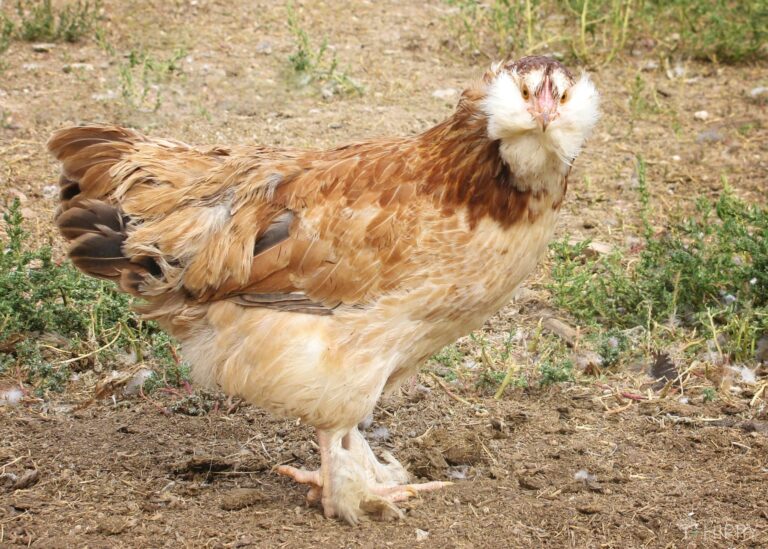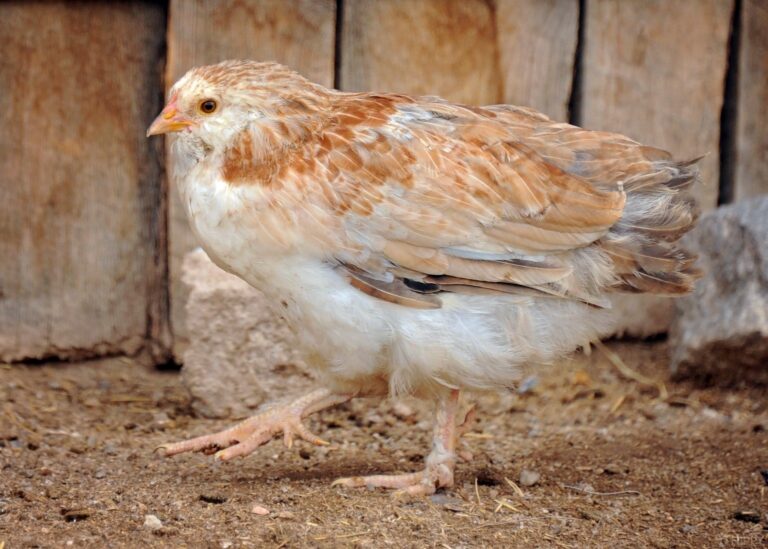One of the most distinguished chickens in the world, the Salmon Faverolles is a very old heritage breed that hails from France. Originally developed as a dual-use chicken, this breed has taken on a new life as one that is beloved by chicken fanciers and as a shoulder, but it’s increasingly popular with backyard owners and homesteaders because of its dependable, even temperament and friendliness.

Although they are harder to find compared to other breeds, their unique attributes make them a one-of-a-kind bird whether you want a mixed flock or not. Keep reading and I’ll tell you about eight facts that you need to know about Salmon Faverolles before you commit to them…
These Chickens Originated from a French village of the Same Name
The Faverolle is a French chicken, but what you might not know is that they originated from a tiny village of the same name: Faverolles.
Originally developed as a solution to problems encountered while confining and transporting the then-common Houdan chicken, the Faverolle is the result of extensive crossbreeding between many different breeds, including the aforementioned Houdan, Brahma, French Rennes, Dorking, and more. And that’s just the birds that we know about!
Sadly, records pertaining to the development for either not kept or destroyed in the intervening years, so the true origins and complete lineage of the Salmon Faverolles are shrouded in mystery today.
Salmon Faverolles Have Been in the US Since the Early 1900s
The Salmon Faverolles has been around for quite a while, but it’s only been in the United States since the early 1900s. They were first imported to New York, and have since spread from there although they are still not particularly common throughout the US.
That is changing, though, thanks to a surge of interest in the breed particularly after the increasing popularity of small-time and backyard chicken keeping generally.
They Tolerate Confinement Very Well
These chickens are well known among seasoned chicken keepers for their propensity to tolerate close confinement very well without developing neuroses or other bad behavioral problems.
As mentioned above, the breed was first initially developed as a solution to challenges encountered with confining and transporting the commercial standard Houdan chicken in France.
Those birds would just go ballistic when put into cages and crates, and the resulting stress showed to quickly compromise their health, leading to outbreaks of diseases, loss of productivity, and other issues.
Remarkably, the Salmon Faverolles displays no such issues unless it is confined in very close quarters for a long time.
If you’ve ever wanted a chicken that you can easily put in a crate and take to the vet or anywhere else, you won’t do better than these birds!
Salmon Faverolles Mature Quickly
Compared to other chicken breeds, the Salmon Faverolles matures somewhat quicker, meaning they can reach a suitable weight for slaughter sooner or, in the case of hens, start laying eggs about a week sooner than most other breeds.
That’s great if you want to get production underway ASAP, and on that note, you should also know that the Salmon Faverolles is well regarded as a winter layer, typically laying eggs continuously even during the coldest months.
They are Inquisitive and Good Natured
These chickens are not just known for their stoicism when it comes to confinement but also for their friendliness and good nature overall.
Although they are sometimes described as standoffish, in reality, these are just supremely calm chickens but that demeanor belies an adventurous and inquisitive spirit.
Owners I know report continually that their chickens are constantly exploring, foraging, and investigating. They seem to have a true love of life and are genuinely curious about things in the world around them.
This inquisitive nature can sometimes lead them to get into trouble, but rarely causes any real problems between themselves owing to their friendliness.
If you enjoy watching your chickens interact with each other and with their environment, you are sure to get lots of enjoyment out of this breed.

Roosters and Hens Look Quite Different
It’s hardly remarkable in the chicken world that roosters and hens look different, but rarely will a rooster look so different from one of his ladies as he will if he belongs to this breed!
Hens are quite pretty, with a pale, slightly pinkish tan or honey color across their back, neck, head, and wings while the rest of their body is a pale white or faintly speckled white with the aforementioned tan color. The underside of their body is usually a dusty off-white or gray.
But the rooster, my goodness, is an entirely different bird! The base colors of the plumage described above are now shot through with a bold, contrasting black on the underside, legs, front of the neck, and breast accented by long and curving iridescent green tail feathers.
The combination of colors is instantly recognizable and absolutely gorgeous. These chickens are one-of-a-kind beauties!
Good Layers and Good Mothers
Although they are most commonly regarded as a showbird or a heritage breed for chicken fanciers today, the Salmon Faverolles still easily proves its dual-use origins. Hens are dependably good layers, cranking out up to 200 eggs yearly with an average of four per week.
More than that, they are also good mothers, and though they have a tendency towards being broody they are nowhere near as fanatical as an Orpington, for instance.
If you want to expand your flock naturally, you can definitely depend on your girls to do the job as they always have.
And if you don’t, that’s fine: they’ll still be more than able to keep you and your family swimming and delicious, medium-sized eggs.
Salmon Faverolles are Capable Foragers
Another great thing that recommends the Salmon Faverolles to your average homesteader is the fact that they are skilled foragers. Owing to their intelligence and inquisitive nature, they do a wonderful job of finding every single edible tidbit that they can on their travels. From bugs to premium bits of tasty plants, they can take care of much of their nutritional requirements themselves if you have a bountiful property.
In any case, it’s always fun watching them track down bugs in the yard!
Tim is a farm boy with vast experience on homesteads, and with survival and prepping. He lives a self-reliant lifestyle along with his aging mother in a quiet and very conservative little town in Ohio. He teaches folks about security, prepping and self-sufficiency not just through his witty writing, but also in person.
Find out more about Tim and the rest of the crew here.
